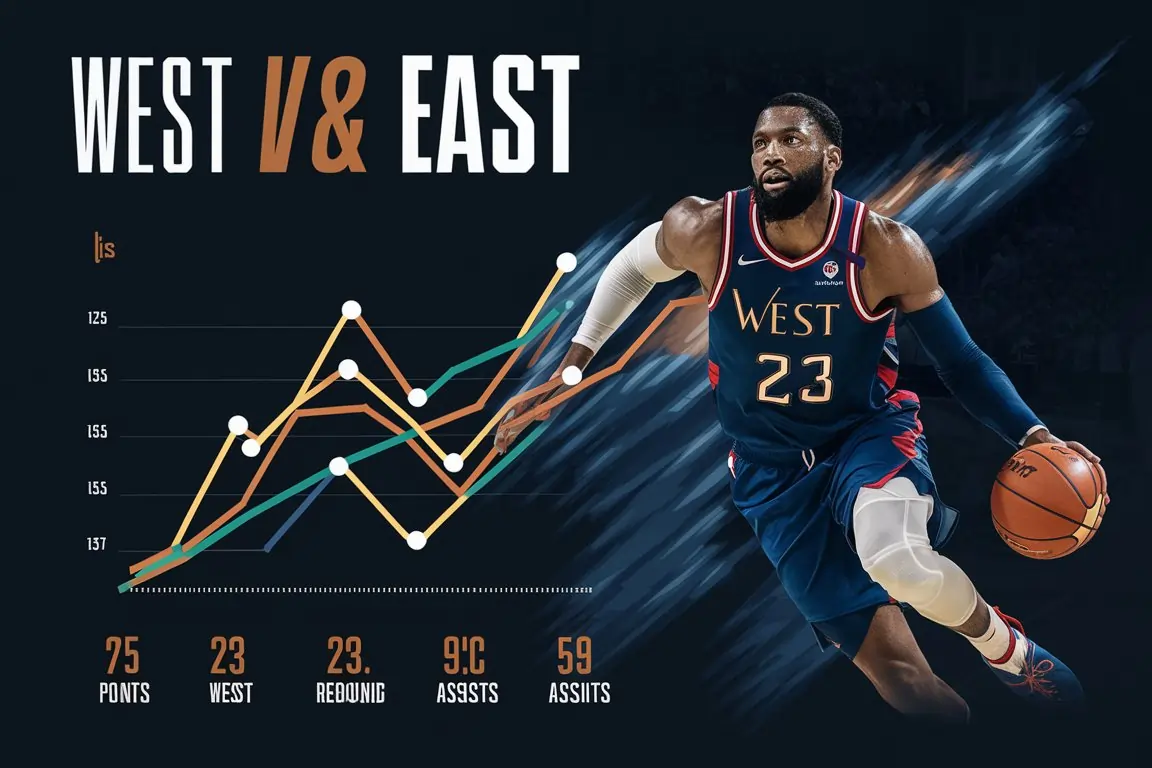The “West vs East” match, a classic showdown between two competitive regions, has always been a platform where individual performances shape the narrative. Fans and analysts eagerly anticipate this clash to see how the stars from the West measure up against their counterparts from the East. Whether it’s in basketball, football, or even esports, the statistical breakdown of player performances is vital to understanding the outcome. This article dives into the key player stats from a hypothetical “West vs East” match, exploring individual contributions, team dynamics, and what the numbers reveal about the game.
1. Offensive Contributions
West’s Top Scorers
The West, known for its aggressive playing style, showcased a powerful offensive performance in the latest match. Three standout players from the West led the scoring charts:
- Player A (West): 34 points, 6 assists, 12 rebounds
- Player B (West): 28 points, 4 assists, 10 rebounds
- Player C (West): 22 points, 8 assists, 8 rebounds
These players contributed a combined total of 84 points, accounting for nearly 60% of the West’s overall score. Player A’s 34 points not only topped the scoring chart but also highlighted his dual ability to grab rebounds and set up assists, demonstrating versatility on the court. Player B’s near double-double emphasized his ability to contribute on both ends of the floor, while Player C’s impressive playmaking ensured the team’s offense flowed smoothly.
East’s Top Scorers
On the other hand, the East, known for its methodical and team-oriented style of play, spread its scoring more evenly:
- Player X (East): 30 points, 9 assists, 5 rebounds
- Player Y (East): 26 points, 7 assists, 11 rebounds
- Player Z (East): 24 points, 5 assists, 6 rebounds
The East’s top trio managed to contribute 80 points combined, but what set them apart was their efficiency. Player X’s playmaking (9 assists) was key to unlocking the West’s defense, while Player Y’s impressive double-double of 26 points and 11 rebounds anchored the East’s attack. Player Z’s contributions in scoring and distributing the ball further strengthened the East’s offensive efforts.
Offensive Takeaways
- West: The West’s strength lay in the individual brilliance of their players, particularly Player A’s ability to score and dominate the boards. Their offense was driven by individual efforts, particularly in fast-break situations.
- East: The East, however, demonstrated a more balanced offensive approach, with more efficient shooting and a higher emphasis on assists. The focus on ball movement allowed for a more collective approach to scoring.
2. Defensive Statistics
West’s Defensive Play
The West’s defense relied heavily on shot-blocking and aggressive rebounds:
- Player A: 3 blocks, 12 rebounds
- Player D (West): 5 blocks, 8 rebounds
- Player E (West): 4 steals, 6 rebounds
Player D was a force in the paint, with 5 blocks preventing several scoring opportunities for the East. The West also demonstrated their physicality, particularly in defensive rebounds, which limited second-chance opportunities for the East. Player E’s 4 steals were instrumental in transition plays that led to fast-break points.
East’s Defensive Play
The East, in contrast, showcased a more structured and disciplined defensive approach:
- Player X: 2 blocks, 5 steals
- Player Y: 3 blocks, 12 rebounds
- Player W (East): 4 steals, 8 rebounds
Player Y was critical in protecting the rim and preventing easy baskets, while Player X’s 5 steals were key to the East’s ability to disrupt the West’s offensive rhythm. The East’s ability to force turnovers created extra possessions, allowing them to stay competitive despite the West’s aggressive offensive play.
Defensive Takeaways
- West: The West dominated in shot-blocking, largely due to their size advantage and aggressive defensive play in the paint. This, however, came at a cost, as they occasionally left themselves vulnerable to fouls and overcommitting on closeouts.
- East: The East’s defense was marked by their ability to force turnovers through disciplined positioning and quick hands. They excelled at disrupting the West’s offense, with steals leading to quick points in transition.
3. Team Dynamics and Passing
While both teams had individual standouts, the difference in passing and team dynamics was stark:
- West: 18 assists total
- East: 24 assists total
The West relied more heavily on individual playmaking, with fewer overall assists. Their focus on isolation plays and exploiting individual matchups led to fewer passes, but more reliance on star players taking difficult shots. However, this also made their offense more predictable at times.
The East, however, emphasized ball movement and spacing. Their 24 assists demonstrated a team-oriented style, making their offense less reliant on any one player. This made them harder to defend, as they spread the ball around to find the best shot available, often forcing the West’s defense to scramble.
5. Final Thoughts and Conclusion
When breaking down the numbers in the West vs East match player stats, it becomes clear that both teams had their strengths. The West’s offensive firepower and defensive shot-blocking were critical in controlling the tempo of the game, while the East’s emphasis on efficiency, ball movement, and forcing turnovers allowed them to remain competitive throughout.



